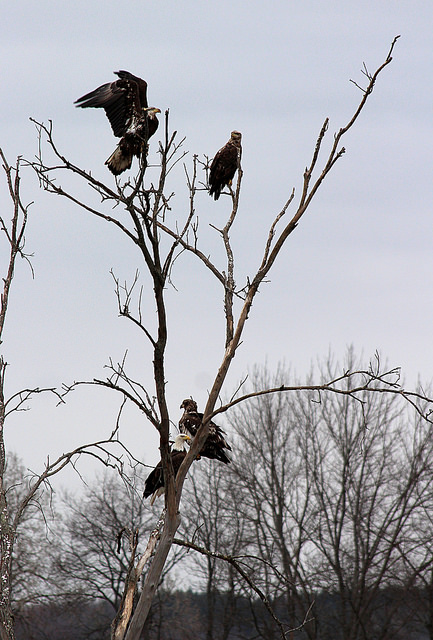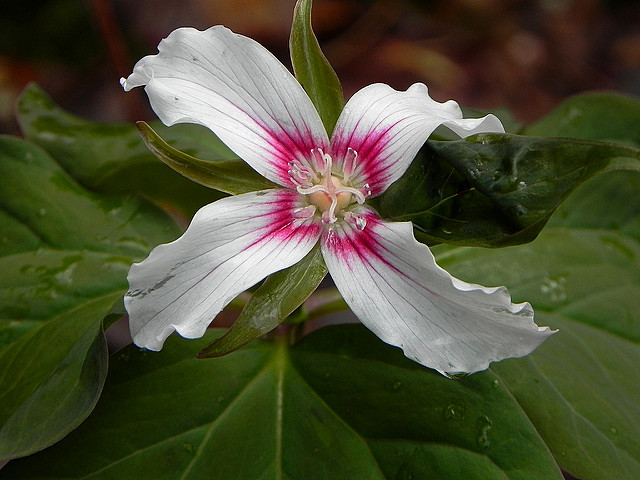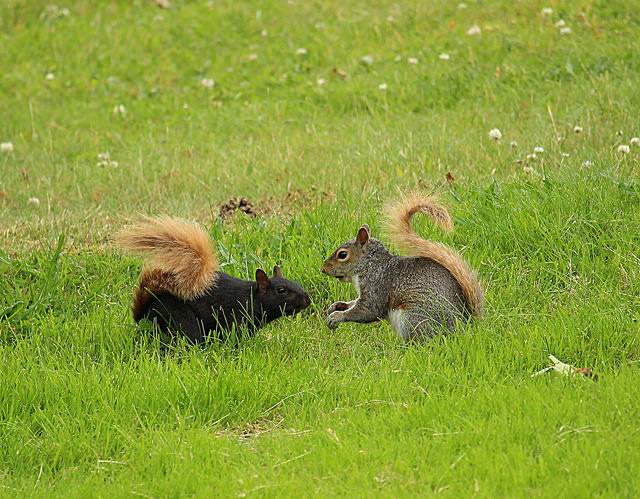How do you know what you saw is what you saw? There are some animals that everyone just seems to know, such as robins, Blue Jays and Raccoons. But what defines the essential “raccoon-ness” of a raccoon? Would you recognize one if it was completely or partially white? Would you know for sure it was a raccoon if it was all black?
These things happen. Albinos are animals that lack any colors at all and appear white with pink eyes. Animals that have white where they normally have another color are called leucistic. Animals that are black, a condition caused by too much color, are called melanistic.
You don’t have to travel far to find one. Audubon has black squirrels, which are simply melanistic versions of Gray Squirrels. Point Gratiot in Dunkirk has melanistic Gray Squirrels with orange tails. No matter what, there is something inherently squirrely about them. A black squirrel is not mistaken for being anything but a squirrel.

Photo by Jeff Tome. Which one of these is a Bald Eagle? All of them! The dark ones are younger eagles that won’t have their white head and tail until they are four years old.
The same is not true of many birds. We use colors to identify birds. Every bird book is loaded with field marks. A robin is identified by its orange breast, the white eye ring around the eye and the brown back. Is a robin still easy to identify if it is drained of all the colors that are used to identify it as a robin? Would you recognize an all-white robin as a robin?
How about a Bald Eagle? Everyone knows the American symbol on sight: white head, white tail, big dark brown body. But what if the eagle was mottled white and brown with a dark line through the eye? Would it still look like an eagle? Or how about one that was all dark brown?
There were four Bald Eagles in a tree at the Audubon Community Nature Center the other day. I saw them from the Blue Heron Overlook at the end of the paved trail. One was a mature eagle, with the perfectly white head and tail. The others were a mish-mash of browns and whites. Bald Eagles don’t get their white heads and tails till they are four years old. You can tell how old they are by where the white patches on them are. Two of the four were three year old eagles, one was only two years old. Most bird books have a chart to tell how old the birds are by the patterns on the body.
Figuring out what something is can be hard enough without nature throwing a curveball. There are over 300 birds that might pass through this area at different times of the year. Sometimes males and females have different colors, like cardinals. Sometimes the juveniles look different than the adults, like the eagles. Other times, one bird comes in many color phases. They may be almost black or almost white, in addition to the males and females and young looking different.
There is an old saying among naturalists: “Birds don’t read books.” A bird might look different than the photo or drawing in the book. It happens. All the millions of one kind of bird out there can’t all look exactly like the one in the book.
The same thing is true of wildflowers. I get excited as spring looms closer. Soon, it will be time to wander the woods and look at the returning birds and wildflowers. It is already happening. I have seen the first Red-winged Blackbirds of spring and the first wildflowers of the year starting to emerge. Tiny leaves from Spring Beauties, Wood Anemones and Marsh Marigolds are emerging under the snow, waiting for the warm weather.

Photo by Jeff Tome. Plants and animals don’t always look like they do in the books and programs designed to help you identify them. This Painted Trillium should have three petals, but has four instead.
Wildflowers can’t read either. Some trilliums, famous for their three petals, have four petals. Some Partridge Berries, listed in the books as having four petals, have five or six petals instead. Red Trilliums may end up yellow. White Trilliums might look pink. Plants and animals have colors and shapes beyond what the books say they might have.
Nature is a never ending mix of interesting things. The possibilities are endless. There might be a rare bird that pops up in an unexpected place or a wildflower that I have never seen before. Sometimes these things show up while I am speeding down a road, forcing me to stop and look closer. Other times, they show up in my backyard and curiosity encourages me to emerge from my hammock to look closer at something crawling below.
Audubon Community Nature Center builds and nurtures connections between people and nature. The Audubon Community Nature Center has trips and programs to help you learn more about what is happening outside, from birding field trips to Happy Hour Hikes. The facility is located at 1600 Riverside Road, just off Route 62 between Warren and Jamestown. Visit auduboncnc.org or call (716) 569-2345 for more information.
Jeff Tome is a naturalist at the Audubon Community Nature Center.


Recent Comments